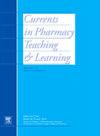Dividing opinions - Reviewing the future calculation curriculum in pre-registration pharmacy technician teaching in England and Wales
IF 1.3
Q3 EDUCATION, SCIENTIFIC DISCIPLINES
引用次数: 0
Abstract
Introduction
Pharmacy Technician practice is continually evolving, yet many areas of the curriculum have stayed the same- including pharmaceutical calculations. This study aimed to review and discuss the teaching and examination of selected calculations within the Certificate in Higher Education in Pharmacy Technician Practice taught in England and Wales.
Methods
Qualified pharmacy technicians, who are current or previous educational supervisors to pre-registration pharmacy technicians, were invited to focus groups to discuss the teaching of four calculations previously highlighted as rarely or never used in the workplace by pharmacy technicians. The calculations discussed were moles, molarity, displacement values and dilutions. After discussing each individual calculation, participants voted to either: 1) continue teaching and examination 2) continue teaching and do not examine 3) remove from teaching/examination and teach as a post-qualification advanced course 4) remove from teaching/examination and do not teach in post-qualification. Voting results and transcripts from the focus groups were analysed using descriptive statistics and framework analysis.
Results
The participants, who were all hospital based, agreed that teaching of these calculations should be reconsidered. Most felt that they should be included as part of the scientific understanding for each concept rather than examined individually. There was no expectation that these calculations would be undertaken by newly qualified pharmacy technicians.
Conclusion
The evolution of healthcare practice means that certain calculations are no longer a routine part of modern pharmacy technician practice. We have highlighted that the teaching and examination of these should be reviewed and altered for future students.
意见分歧——对英格兰和威尔士注册前药学技术人员教学中未来计算课程的回顾
药学技术人员的实践不断发展,但课程的许多领域保持不变-包括药物计算。本研究旨在回顾和讨论英格兰和威尔士高等教育药学技术人员实践证书中选定计算的教学和考试。方法邀请在职或曾任预注册药学技术人员教育督导的合格药学技术人员为焦点小组,讨论以往被强调很少或从未在工作场所使用的四种计算方法的教学。讨论的计算是摩尔、摩尔浓度、位移值和稀释度。在讨论每一项计算后,与会者投票决定:1)继续教学和考试2)继续教学,不考试3)退出教学/考试,作为资格后高级课程教学4)退出教学/考试,不教学资格后。使用描述性统计和框架分析对焦点小组的投票结果和记录进行了分析。结果所有以医院为基础的参与者一致认为,这些计算的教学应该重新考虑。大多数人认为,它们应该作为对每个概念的科学理解的一部分,而不是单独审查。没有预料到这些计算将由新获得资格的药学技术人员进行。结论医疗保健实践的发展意味着某些计算不再是现代药学技术人员实践的常规部分。我们强调,这些课程的教学和考试应该为未来的学生进行检讨和修改。
本文章由计算机程序翻译,如有差异,请以英文原文为准。
求助全文
约1分钟内获得全文
求助全文
来源期刊

Currents in Pharmacy Teaching and Learning
EDUCATION, SCIENTIFIC DISCIPLINES-
CiteScore
2.10
自引率
16.70%
发文量
192
 求助内容:
求助内容: 应助结果提醒方式:
应助结果提醒方式:


